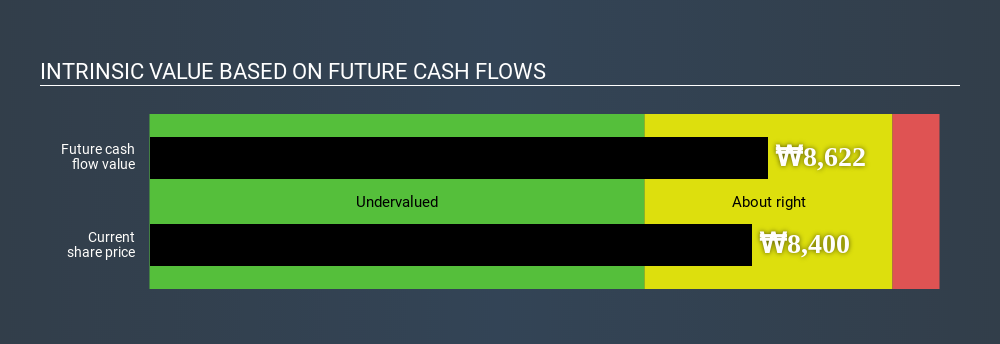- South Korea
- /
- Trade Distributors
- /
- KOSE:A122900
A Look At The Intrinsic Value Of iMarketKorea Inc. (KRX:122900)

How far off is iMarketKorea Inc. (KRX:122900) from its intrinsic value? Using the most recent financial data, we'll take a look at whether the stock is fairly priced by projecting its future cash flows and then discounting them to today's value. I will use the Discounted Cash Flow (DCF) model. It may sound complicated, but actually it is quite simple!
Remember though, that there are many ways to estimate a company's value, and a DCF is just one method. Anyone interested in learning a bit more about intrinsic value should have a read of the Simply Wall St analysis model.
Check out our latest analysis for iMarketKorea
Is iMarketKorea fairly valued?
We use what is known as a 2-stage model, which simply means we have two different periods of growth rates for the company's cash flows. Generally the first stage is higher growth, and the second stage is a lower growth phase. To start off with, we need to estimate the next ten years of cash flows. Seeing as no analyst estimates of free cash flow are available to us, we have extrapolate the previous free cash flow (FCF) from the company's last reported value. We assume companies with shrinking free cash flow will slow their rate of shrinkage, and that companies with growing free cash flow will see their growth rate slow, over this period. We do this to reflect that growth tends to slow more in the early years than it does in later years.
Generally we assume that a dollar today is more valuable than a dollar in the future, so we discount the value of these future cash flows to their estimated value in today's dollars:
10-year free cash flow (FCF) estimate
| 2020 | 2021 | 2022 | 2023 | 2024 | 2025 | 2026 | 2027 | 2028 | 2029 | |
| Levered FCF (₩, Millions) | ₩29.9b | ₩26.3b | ₩24.4b | ₩23.5b | ₩23.1b | ₩23.1b | ₩23.4b | ₩23.9b | ₩24.5b | ₩25.2b |
| Growth Rate Estimate Source | Est @ -18.69% | Est @ -11.93% | Est @ -7.19% | Est @ -3.88% | Est @ -1.55% | Est @ 0.07% | Est @ 1.21% | Est @ 2% | Est @ 2.56% | Est @ 2.95% |
| Present Value (₩, Millions) Discounted @ 11% | ₩26.9k | ₩21.3k | ₩17.8k | ₩15.5k | ₩13.7k | ₩12.4k | ₩11.3k | ₩10.4k | ₩9.6k | ₩8.9k |
("Est" = FCF growth rate estimated by Simply Wall St)
Present Value of 10-year Cash Flow (PVCF) = ₩148b
The second stage is also known as Terminal Value, this is the business's cash flow after the first stage. The Gordon Growth formula is used to calculate Terminal Value at a future annual growth rate equal to the 10-year government bond rate of 3.9%. We discount the terminal cash flows to today's value at a cost of equity of 11%.
Terminal Value (TV)= FCF2029 × (1 + g) ÷ (r – g) = ₩25b× (1 + 3.9%) ÷ 11%– 3.9%) = ₩366b
Present Value of Terminal Value (PVTV)= TV / (1 + r)10= ₩366b÷ ( 1 + 11%)10= ₩129b
The total value, or equity value, is then the sum of the present value of the future cash flows, which in this case is ₩277b. The last step is to then divide the equity value by the number of shares outstanding. Relative to the current share price of ₩8.4k, the company appears about fair value at a 2.6% discount to where the stock price trades currently. The assumptions in any calculation have a big impact on the valuation, so it is better to view this as a rough estimate, not precise down to the last cent.

Important assumptions
Now the most important inputs to a discounted cash flow are the discount rate, and of course, the actual cash flows. You don't have to agree with these inputs, I recommend redoing the calculations yourself and playing with them. The DCF also does not consider the possible cyclicality of an industry, or a company's future capital requirements, so it does not give a full picture of a company's potential performance. Given that we are looking at iMarketKorea as potential shareholders, the cost of equity is used as the discount rate, rather than the cost of capital (or weighted average cost of capital, WACC) which accounts for debt. In this calculation we've used 11%, which is based on a levered beta of 1.032. Beta is a measure of a stock's volatility, compared to the market as a whole. We get our beta from the industry average beta of globally comparable companies, with an imposed limit between 0.8 and 2.0, which is a reasonable range for a stable business.
Next Steps:
Valuation is only one side of the coin in terms of building your investment thesis, and it shouldn’t be the only metric you look at when researching a company. The DCF model is not a perfect stock valuation tool. Rather it should be seen as a guide to "what assumptions need to be true for this stock to be under/overvalued?" If a company grows at a different rate, or if its cost of equity or risk free rate changes sharply, the output can look very different. For iMarketKorea, We've compiled three pertinent aspects you should look at:
- Risks: Be aware that iMarketKorea is showing 3 warning signs in our investment analysis , and 1 of those is concerning...
- Other High Quality Alternatives: Do you like a good all-rounder? Explore our interactive list of high quality stocks to get an idea of what else is out there you may be missing!
- Other Environmentally-Friendly Companies: Concerned about the environment and think consumers will buy eco-friendly products more and more? Browse through our interactive list of companies that are thinking about a greener future to discover some stocks you may not have thought of!
PS. The Simply Wall St app conducts a discounted cash flow valuation for every stock on the KOSE every day. If you want to find the calculation for other stocks just search here.
Love or hate this article? Concerned about the content? Get in touch with us directly. Alternatively, email editorial-team@simplywallst.com.
This article by Simply Wall St is general in nature. It does not constitute a recommendation to buy or sell any stock, and does not take account of your objectives, or your financial situation. We aim to bring you long-term focused analysis driven by fundamental data. Note that our analysis may not factor in the latest price-sensitive company announcements or qualitative material. Simply Wall St has no position in any stocks mentioned. Thank you for reading.
About KOSE:A122900
iMarketKorea
Operates as an industrial material distribution service company in South Korea and internationally.
Proven track record with adequate balance sheet.
Market Insights
Community Narratives



